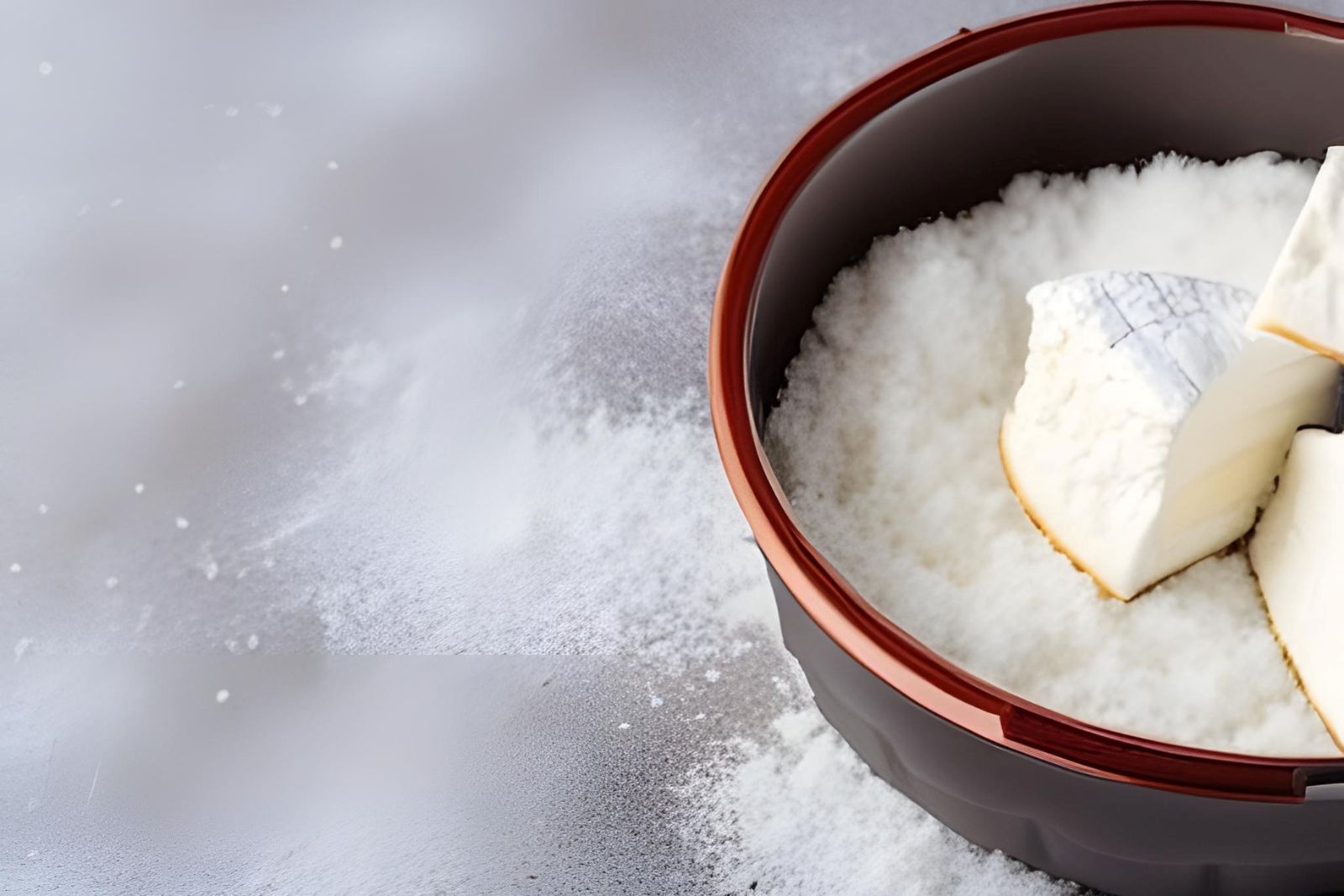
Goat cheese, with its creamy and tangy flavor, is a versatile ingredient that adds a delightful touch to various dishes. Whether you have an abundance of goat cheese or want to take advantage of a sale, freezing it can help prolong its shelf life and preserve its taste and texture. Freezing goat cheese allows you to have it on hand whenever you need it, whether it’s for salads, spreads, or as a topping for pizzas and pastas. By following the proper freezing techniques, you can ensure that the goat cheese retains its quality and remains deliciously creamy after thawing. With frozen goat cheese in your freezer, you can effortlessly elevate your recipes with its distinct flavor, making it a convenient and flavorful addition to your culinary repertoire.
Here are the steps to freeze goat cheese:
Step 1: Allow the goat cheese to cool down
Once you have purchased or made the goat cheese, it’s important to allow it to cool down completely before freezing. This step may seem simple, but it plays a critical role in maintaining the quality of the cheese during the freezing process.
When goat cheese is warm, it tends to retain moisture. If you were to freeze it immediately, the moisture trapped within the cheese would form ice crystals, which can lead to a change in texture and affect its overall quality. By allowing the cheese to cool down, you give it time to stabilize and reduce the moisture content, ensuring a better freezing outcome.
Cooling the goat cheese also helps to minimize condensation. When you transfer warm cheese directly into the freezer, the temperature difference between the warm cheese and the cold freezer can cause moisture in the air to condense on the surface of the cheese. This moisture can result in freezer burn or ice crystals, which can negatively impact the taste and texture of the cheese.
To cool the goat cheese, you can leave it at room temperature for a short while after purchasing or making it. Avoid leaving it out for an extended period, as this can promote bacterial growth. Once the cheese has reached room temperature, you can proceed with the freezing process.
Step 2: Decide on portion sizes
When freezing goat cheese, it’s essential to consider whether you want to freeze it as a whole or divide it into smaller portions. The decision you make depends on your preferences and how you plan to use the cheese after thawing.
Freezing smaller portions of goat cheese has its advantages. Firstly, it allows for more flexibility when using the cheese later on. If you only need a small amount for a particular recipe or dish, you can easily take out the desired portion without having to thaw the entire block of cheese. This is particularly convenient when you want to add a touch of goat cheese to salads, pasta dishes, or sandwiches.
Furthermore, freezing goat cheese in smaller portions also reduces waste. By dividing the cheese into manageable sizes, you can avoid thawing more than you need, thus preserving the rest for future use. This can be especially helpful if you have a large block of goat cheese that you don’t plan to use all at once.
On the other hand, freezing goat cheese as a whole may be suitable for certain recipes or preferences. If you often use larger quantities of goat cheese or have specific recipes that call for an entire block, freezing it as a whole can be more convenient. It allows you to thaw the entire block at once without the need for portioning or extra preparation.
Ultimately, the decision on portion sizes depends on your intended usage and convenience. Consider how you typically use goat cheese and whether freezing it in smaller portions aligns better with your cooking habits. It’s worth noting that regardless of the portion size, proper wrapping and labeling are crucial to maintaining the quality and ease of use when thawing frozen goat cheese.
Step 3: Wrap each portion tightly in plastic wrap
When freezing goat cheese, it is crucial to wrap each portion tightly in plastic wrap. This step serves two important purposes: maintaining flavor and preventing the cheese from absorbing unwanted odors from the freezer.
By wrapping each portion tightly in plastic wrap, you create a barrier that helps to preserve the flavor of the goat cheese. The plastic wrap seals the cheese, preventing air exposure and reducing the risk of moisture loss. This is particularly important because exposure to air can lead to oxidation, causing the cheese to develop off-flavors or become dry.
Additionally, tightly wrapping the goat cheese in plastic wrap helps to protect it from absorbing odors from other foods in the freezer. Cheese has a porous structure, which makes it susceptible to picking up surrounding odors easily. By using plastic wrap, you create an additional layer of protection that helps to isolate the cheese and maintain its unique flavor profile.
When wrapping the goat cheese, ensure that the plastic wrap is snug and covers the cheese entirely. Avoid leaving any gaps or loose ends that could allow air or odors to penetrate. Press the plastic wrap firmly against the surface of the cheese to create a tight seal.
It’s worth noting that using multiple layers of plastic wrap or opting for plastic wrap specifically designed for freezing can provide even better protection against air exposure and odors. These specialized wraps are often thicker and more resistant to moisture, enhancing the preservation of the goat cheese’s flavor and texture.
Step 4: Double-wrap with aluminum foil
After wrapping each portion of goat cheese tightly in plastic wrap, the next step is to double-wrap it with aluminum foil. This additional layer of protection serves two key purposes: guarding against freezer burn and preserving the cheese’s moisture and texture.
Freezer burn occurs when food is exposed to air and becomes dehydrated. It can negatively impact the quality and taste of goat cheese. By double-wrapping the cheese with aluminum foil, you create an extra barrier that helps to prevent air from reaching the surface of the cheese. This reduces the risk of freezer burn and helps maintain the cheese’s moisture content.
Aluminum foil is a material that offers excellent insulation properties. It helps to shield the goat cheese from temperature fluctuations in the freezer and acts as a barrier against moisture loss. This is particularly important as temperature variations and moisture evaporation can affect the cheese’s texture and potentially lead to a dry or crumbly consistency.
Additionally, the aluminum foil provides an extra layer of protection against odors and flavors from other foods in the freezer. It helps to isolate the goat cheese and maintain its distinctive taste, ensuring that it remains untainted by surrounding aromas.
When wrapping the goat cheese with aluminum foil, make sure to cover it completely, sealing all sides tightly. This will create a snug and secure package that minimizes the exposure of the cheese to air and potential contaminants.
Step 5: Label and date the package
After wrapping each portion of goat cheese tightly in plastic wrap and aluminum foil, it is important to label and date the package. This simple step of adding clear identification and freezing information is essential for easy identification and to keep track of the freezing duration.
By labeling the package, you can easily identify the contents of the wrapped goat cheese without the need to unwrap it. Use a permanent marker or label stickers to write a brief description of the goat cheese, such as “Goat Cheese” or any specific details that may be helpful for identification, like the type or flavor of the cheese.
In addition to the description, it is crucial to include the date of freezing. Write the date on the package to keep track of how long the goat cheese has been in the freezer. This is particularly important because goat cheese is best consumed within a specific time frame to maintain its quality. Generally, goat cheese can be stored in the freezer for up to three months without compromising its taste and texture.
By noting the freezing date, you can easily monitor the storage time and plan accordingly. This helps to ensure that you use the goat cheese within the recommended time frame and avoid potential degradation in flavor or quality that may occur with extended freezer storage.
Having clear labeling and dating also allows you to prioritize the usage of frozen goat cheese based on freshness. It enables you to identify the oldest packages and consume them first, ensuring you enjoy the goat cheese at its best.
Remember to label each package individually, especially if you have multiple portions of goat cheese stored in the freezer. This will help you keep track of the specific packages you need and avoid any confusion when retrieving them.
Step 6: Place the wrapped goat cheese in the freezer
Once you have wrapped and labeled each portion of goat cheese, the final step is to find a suitable spot in your freezer and store the wrapped cheese. Proper storage is essential to maintain the quality, flavor, and texture of the goat cheese until you are ready to use it.
When selecting a spot in the freezer, it’s important to consider a few factors. Firstly, choose an area where the goat cheese won’t get squished or compressed by other items. Placing it in a location where it can maintain its shape will help preserve its texture and prevent it from becoming misshapen or damaged.
Additionally, try to avoid areas in the freezer that are prone to temperature fluctuations. Fluctuating temperatures can impact the quality of the cheese by causing it to thaw and refreeze, which can affect its texture and taste. Choose a spot away from the freezer door or any areas that are frequently exposed to warmer temperatures, such as near the freezer vents.
Organizing the freezer by placing the wrapped goat cheese in a designated section or using containers or baskets can help keep it separated from other items and minimize the risk of damage or accidental squishing.
It’s also worth noting that if you have multiple portions of goat cheese, you can stack them on top of each other. However, ensure that they are properly wrapped and that the weight of the cheese on top is evenly distributed to avoid any crushing or deformation.
Other related questions
How do I thaw goat cheese?
Thawing goat cheese is a simple process that requires a gentle approach to preserve its texture and flavor. The recommended method is to transfer the frozen goat cheese from the freezer to the refrigerator and let it thaw slowly overnight. Avoid thawing it at room temperature or using a microwave, as this can lead to uneven thawing or undesirable changes in the cheese’s consistency. Once thawed, the goat cheese can be used in various recipes or enjoyed as is. Remember to discard any thawed cheese that has been left at room temperature for more than two hours to ensure food safety.
How long can I freeze goat cheese?
Goat cheese can be safely frozen for up to three months without compromising its quality. Freezing it beyond this time may result in a potential decline in taste and texture. It is recommended to consume frozen goat cheese within a three-month period to enjoy it at its best. Proper storage and handling during freezing can help maintain the cheese’s quality for the intended duration.
Can I refreeze goat cheese after it has been previously thawed?
It is generally not recommended to refreeze goat cheese after it has been thawed. Freezing and thawing can affect the texture and quality of the cheese, and multiple freeze-thaw cycles can further compromise its taste and consistency. Each time cheese goes through the freezing and thawing process, it experiences changes in moisture content and structure, potentially leading to a less desirable texture. To maintain the best quality, it is advised to use the thawed goat cheese within a reasonable time frame and avoid refreezing it.
How do I know if my frozen goat cheese has gone bad?
When assessing if frozen goat cheese has gone bad, there are a few indicators to look out for. Firstly, check for any signs of freezer burn, such as discoloration, dryness, or the formation of ice crystals on the surface of the cheese. Additionally, if the cheese develops an off-smell or an unusual odor, it may indicate spoilage. Changes in texture, such as excessive softness, mushiness, or a crumbly consistency, can also be signs of deterioration. Trust your senses and if in doubt, it’s best to err on the side of caution and discard the frozen goat cheese if you suspect it has gone bad.
Can I use frozen goat cheese with fresh ones?
While it is possible to use frozen goat cheese alongside fresh ones, there may be some differences in texture and consistency. Freezing and thawing can cause slight changes in the moisture content and structure of the cheese, potentially resulting in a softer or crumblier texture compared to fresh goat cheese. However, frozen goat cheese can still be utilized in various recipes that call for crumbled, melted, or mixed cheese. It’s important to note that the specific application and personal preference will determine whether the texture of the thawed goat cheese aligns with the desired outcome.
Will freezing goat cheese affect its flavor and texture?
Freezing goat cheese can slightly affect its flavor and texture. The moisture content of the cheese may change during freezing and thawing, resulting in a softer or crumblier texture compared to fresh goat cheese. Additionally, some individuals may notice a slight difference in taste after freezing, although the overall flavor profile should remain relatively intact. Proper wrapping and storage techniques can help minimize these effects and preserve the best possible quality of the frozen goat cheese.
Should I freeze goat cheese in its original packaging?
It is generally not recommended to freeze goat cheese in its original packaging. The packaging that comes with the goat cheese is typically not designed for long-term freezing, and it may not provide sufficient protection against freezer burn. Instead, it is advisable to wrap the goat cheese tightly in plastic wrap and then double-wrap it with aluminum foil to create a better barrier against air and moisture. This will help maintain the quality and flavor of the goat cheese during freezing.
Can I freeze goat cheese that has already been crumbled or sliced?
Yes, you can freeze goat cheese that has already been crumbled or sliced. However, it’s important to ensure proper packaging to prevent moisture loss and maintain its quality. Place the crumbled or sliced goat cheese in an airtight container or wrap it tightly with plastic wrap and aluminum foil to minimize exposure to air. This will help preserve the texture and flavor of the goat cheese when freezing.








